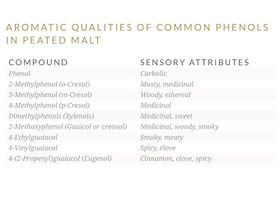Phenols: Difference between revisions
(added links) |
m (Added image from Box Whisky) |
||
| Line 1: | Line 1: | ||
[[File:Phenol attributes.jpg|thumb|280px|right|Phenol Sensory Chart]] | [[File:Phenol attributes.jpg|thumb|280px|right|Phenol Sensory Chart]] | ||
[[File:Phenols_comp.png|thumb|280px|right|Phenol expression]] | |||
In organic chemistry, phenols, sometimes called phenolics, are a class of chemical compounds consisting of a hydroxyl group (—OH) bonded directly to an aromatic hydrocarbon group. The simplest of the class is phenol, which is also called carbolic acid C6H5OH. Phenolic compounds are classified as simple phenols or polyphenols based on the number of phenol units in the molecule. Synonyms are arenols or aryl alcohols. Phenolic compounds are synthesized industrially; they also are produced by plants and microorganisms, with variation between and within species. | In organic chemistry, phenols, sometimes called phenolics, are a class of chemical compounds consisting of a hydroxyl group (—OH) bonded directly to an aromatic hydrocarbon group. The simplest of the class is phenol, which is also called carbolic acid C6H5OH. Phenolic compounds are classified as simple phenols or polyphenols based on the number of phenol units in the molecule. Synonyms are arenols or aryl alcohols. Phenolic compounds are synthesized industrially; they also are produced by plants and microorganisms, with variation between and within species. | ||
Latest revision as of 05:02, 5 June 2018
In organic chemistry, phenols, sometimes called phenolics, are a class of chemical compounds consisting of a hydroxyl group (—OH) bonded directly to an aromatic hydrocarbon group. The simplest of the class is phenol, which is also called carbolic acid C6H5OH. Phenolic compounds are classified as simple phenols or polyphenols based on the number of phenol units in the molecule. Synonyms are arenols or aryl alcohols. Phenolic compounds are synthesized industrially; they also are produced by plants and microorganisms, with variation between and within species.
In distilling Phenols create aroma and flavor profiles. Most famously is the Peat phenols of Islay Scotch.
The phenolic compounds, in particular phenol and cresol along with eugenol and guaiacol are the source of particularly strong, smoky and bitter flavours and aromas found within whisky. Eugenols occur in whisky and other spirits matured in oak barrels, imparting a strong strong and bitter flavours of clove and cinnamon.
Phenols primarily contribute bitterness and smokiness to a whisky’s flavor. They’re particularly noticeable in whisky produced from barley that was dried using peat fires, as is still the case in a number of Scottish distilleries. The burning produces the phenolic compounds in the smoke, which are then absorbed by the barley. Charring of the barrels in which the whisky is later matured can also lead to the presence of phenolic compounds in the spirit.
Phenol, cresols, xylenol and guaiacol are amongst the most important phenolic compounds in whisky, in terms of contribution to flavor. Guaiacol is also somewhat responsible for smokey flavors in coffee, and in smoked meats. Compounds called cresols are the culprits when it comes to the oft-mentioned similarity in aroma between Scotch whisky and band-aids. The particular compound responsible is meta-cresol, which has a medicinal aroma, and was also traditionally used in band-aids as an antiseptic. Eugenol is also present in many whiskies, a compound more commonly found in cloves, and partly responsible for their spicy aroma.
External Links
- Phenols at Wikipedia
- Phenol Fables:Peat's Secrets Uncovered
- Adding Water to enhance guaiacol flavor
- Phenolic Compounds in Whisky
- The Magic and Mayhem of Whisky Phenols
- Youtube: Ardbeg Phenols with Bryony MacIntyre
- Phenolic flavor sources in beer
Phenol Research
- Dilution of whisky – the molecular perspective
- Whiskey Phenol Analysis PDF
- THE ESTIMATION AND IDENTIFICATION OF PHENOLS IN MALT FROM PEAT-FIRED KILNS PDF
- Whisky polyphenols and their potential health effects (Charts of phenols by age)
- Phenolic compounds in beer - PDF
- Phenolic Content in Different Barley Varieties

